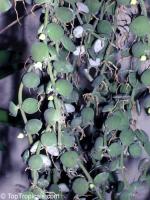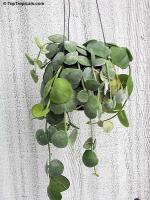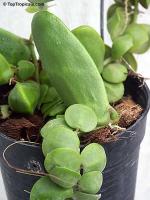|
|
DischidiaFamily: Asclepiadaceae.
| Dischidia rafflesiana |
Common name(s): Ant plant |
|
 |
Genus of about 80 species of trailing-scandent, epyphytic herbaceous perennials, from W. Asia to W. Pacific.
As myrmecophilous or ant-loving plants, several dischidias are particularly intriguing. Ants inhabit the inflated, often hollow leaves, using them as nurseries for their young and as garbage dumps. The plants benefit from the ants' carbon dioxide and waste products.
Dischidias also bear small flowers. Exellent in a terrarium. |
|
| Growing conditions |
Watering and misting |
Propagation |
| Grow in epiphytic bromeliad mix in bright filtered light. Keep potbound. Minium temperature 55F (13C). |
Water freely, mist frequently, foliar-fertilize. |
Take semi-ripe cuttings and grow in a shaded, closed case with gentle bottom heat, or layer. |
|
Dischidia minor, Dischidia nummularia |
|
|
Origin: Malaya, Australia.
Climbing by attaching its roots to the host tree, this epiphyte can reach a height 9 ft. It has pendent stems, and small button-like, silver-grey leaves. The inflorescence is an umbel of small white tubular flowers with a ring of sparse hairs inside. Masses of fluffy seeds develop after the blooms have faded. It prefers a heavily shaded position in a drought, and frost free area. Fresh seed is sometimes used to propagate this plant, or by division in warm, and moist greenhouse conditions. It lives on many types of trees but mostly paperbark trees (Melaleuca species) on rainforest borders. This little vine has cute little coin shaped leaves and can be variegated with cream and gray. It can be grown as a hanging basket or pot, or on moss or bark. It likes bright light but not direct sun over the plant. The mix needs to be kept moderately dry between waterings. They don't like too much water and misting the plant once or twice a week should do the job. Liquid feeding once a month with half strength is adequate. It is also good for terrariums. |
 |
|
Dischidia ovata |
|
|
Origin: New Guinea.
Miniature hoya with striped tiny 1/2" leaves, dark green and white, exactly like watermelon stripes! Very unusual and eye-catching. It's an epyphite, can be grown in orchid medium or light potting mix with lots of bark conditioner. Beautiful house plant. |
 |
|
Dischidia pectinoides |
|
|
Origin: Philippines. Dischidia pectinoides is a curious little climber. Some of its leaves look like tiny balloons. In nature, the balloon type leaves provide shelter for ants in exchange for carbon dioxide. Has tiny red flowers. The wiry stems of this species are thin, twining, and rooting freely. It has oblong leaves that taper at the apex, and grow 3/4-inch long, and 3/8-inch wide. Some leaves are hollow, pear-shaped, and grow to 4-inches long, opening at the base. This foliage is used as a food storage area for ants. The whole plant is greyish-green, except the small, purplish-red flowers that appear in the leaf axils in spring. To grow this plant successfully, place it in a warm, shady position with something to twine its branches around. The older this plant gets, the faster it produces growth. |
 |
|
Dischidia platyphylla |
|
|
Growing to 6-feet long, this climbing vine has many thin, twining branches. The leaves are opposite, and some foliage is small, greyish-green, and oval. They also have food storage leaves that are larger, and kidney shaped. Buff colored flowers grow to 1/8-inch in diameter. These blooms are shaped like water pitchers, and occur in the leaf axils. Fresh seed or cuttings can be used to start this plant. Keep this species in a heated, moist greenhouse in cool climates as it is a drought, and frost tender plant.It grows in rainforests, and only grows as an epiphyte. |
 |
|
Dischidia rafflesiana, Dischidia major |
|
|
Origin: India to Australia. An unusual succulent/epyphite vine with inflated, hollow leaves resembling baloons, in nature used by ants for nesting. It is a strange Hoya relative with modified leaves that look like a cluster of bananas. These leaves house ants in the wild; the ants get a free house and the plant gets protection from predatory insects. This tropical epiphyte can be grown in moss, orchid bark, or on bark. It also has round coin-like more normal leaves. Likes warmth, bright light, and high humidity. Grows to about 16-feet long, having many wiry, and twining stems. On the stems, adventitious roots form at the leaf joints to attach it to the host plant. The leaves are opposite, starting small, and rounded, then the modified food storage leaves becoming large, pitcher-like, and hollow. However, the cavity in the leaf fills with its own roots. These leaves are fleshy, green outside, and purplish inside. Flowers are yellowish, fleshy, and arranged in umbels. USDA Zone 11. Easy to grow as a houseplant or in the drier areas of terrariums. Likes bright light and needs to dry out between watering. |
 |
User-submitted additions and corrections:
Phyllis
Ohio U.S.A.
10th Aug 2008
|
I grow a few types of these. They hand in my laundry room windows where they get south and east light. I water them with rain water and use a mild solution of orchid fertilizer once a month. |
|






